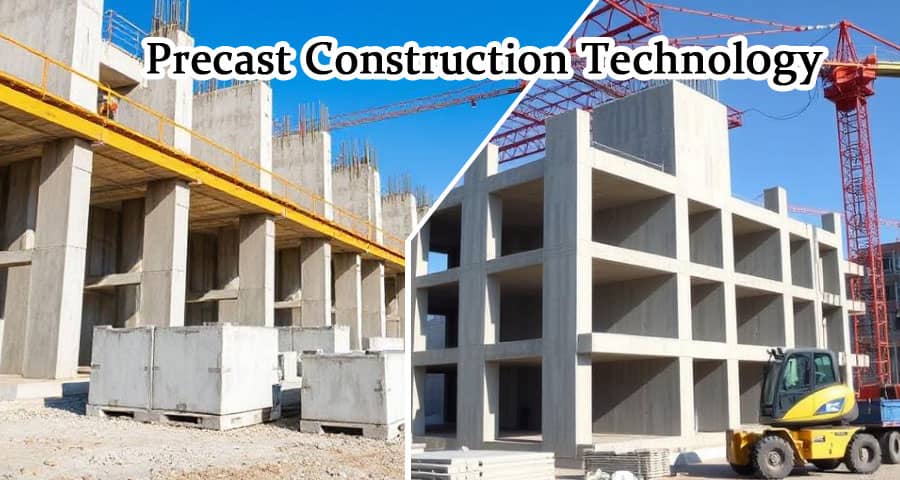What is Precast Construction Technology in Real Estate?

Precast construction technology refers to a building method where structural components are manufactured in a controlled factory environment and then transported to the construction site for assembly. Unlike conventional construction methods where everything is built on-site, precast components include walls, beams, columns, slabs, staircases, and more - each cast in reusable molds and cured under optimal conditions before installation.
This technology has gained significant traction in the real estate sector due to its efficiency, speed, and superior quality control, setting a new benchmark in modern construction.
Key Components of Precast Construction
Precast Concrete Panels
These are the most common components and can be used for load-bearing and non-load-bearing walls. They are manufactured with embedded insulation and come pre-finished, reducing the need for additional layers on-site.
Precast Beams and Columns
Serving as the backbone of structural integrity, precast beams and columns are custom-designed for each project, allowing precise architectural detailing while ensuring robustness.
Precast Slabs and Floors
Floor systems such as hollow-core slabs or solid slabs are fabricated off-site and lifted into place, enabling quicker floor assembly and reducing formwork needs.
Staircases and Landings
These components are produced as modular units, which are quickly installed on-site with minimal labor and finishing requirements.
Advantages of Precast Construction Technology in Real Estate
1. Time Efficiency
One of the most significant benefits is faster project completion. While site work and foundation preparation are underway, structural elements are simultaneously fabricated, drastically reducing the overall construction schedule.
2. Enhanced Quality and Durability
Factory settings allow for stringent quality control, precise measurements, and optimal curing conditions. This results in stronger, more durable components with better resistance to environmental impacts, ensuring long-term structural performance.
3. Cost Effectiveness
While initial investments in molds and transportation may be higher, the long-term savings on labor, material waste, and project delays make precast construction financially viable for large-scale real estate developments.
4. Reduced On-Site Labor
With major components pre-assembled, labor requirements on-site are minimized, leading to fewer safety incidents and lower manpower costs.
5. Sustainability and Waste Reduction
Precast production is inherently sustainable. By optimizing material use, recycling formwork, and minimizing waste, it contributes to greener building practices - aligning with eco-conscious real estate trends.
Applications of Precast Technology in Real Estate Development
Residential Projects
From multi-storey apartments to affordable housing units, precast technology accelerates delivery without compromising on design aesthetics or structural soundness.
Commercial Complexes
Shopping malls, office buildings, and tech parks benefit immensely from customized precast modules that meet architectural and functional specifications.
Infrastructure and Utilities
Precast is not limited to buildings. It extends to utility structures, flyovers, drainage systems, and retaining walls, enabling smart city infrastructure with reduced execution timelines.
Comparing Precast vs Traditional Construction
| Feature | Precast Construction | Traditional Construction |
| Speed | Fast assembly with simultaneous fabrication | Sequential process, slower timeline |
| Quality Control | Factory-monitored precision | Site-dependent variable quality |
| Labor | Minimal on-site workforce | High dependency on labor |
| Waste | Controlled waste management | Higher material wastage |
| Weather Dependence | Minimal impact | Often affected by weather conditions |
| Cost | Higher initial, lower lifecycle cost | Lower initial, higher maintenance cost |
Challenges in Precast Construction
Despite its advantages, precast technology faces logistical and technical challenges:
- Transportation and Handling: Moving large elements to the site requires specialized equipment and careful planning.
- Design Limitations: Early-stage planning is critical. Late design changes can be difficult and costly.
- Jointing and Connections: Ensuring the integrity of connections between precast elements is vital for stability and performance.
Recent Innovations in Precast Technology
Modern precast systems incorporate Building Information Modeling (BIM), allowing precise 3D visualizations and seamless coordination between architects, engineers, and construction managers. Additionally, the use of lightweight concrete, carbon-fiber reinforcements, and modular formwork systems is pushing the boundaries of what's possible in precast.
Smart Precast Panels
Some manufacturers now offer precast panels embedded with sensors, which help monitor structural health over time, enhancing maintenance planning and long-term safety.
Future of Precast in Real Estate
The precast industry is on the cusp of a technological transformation, driven by:
- AI-powered design tools
- Automation in factories
- 3D printing of molds and reinforcements
- Increased government support for modular housing
With rising urbanization and the need for scalable, fast, and sustainable construction solutions, precast technology is poised to become the cornerstone of future real estate development.
Please watch the following short video for Precast Construction Technology in Real Estate
